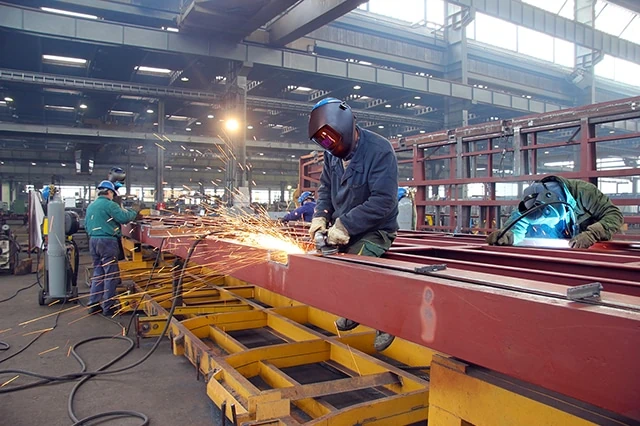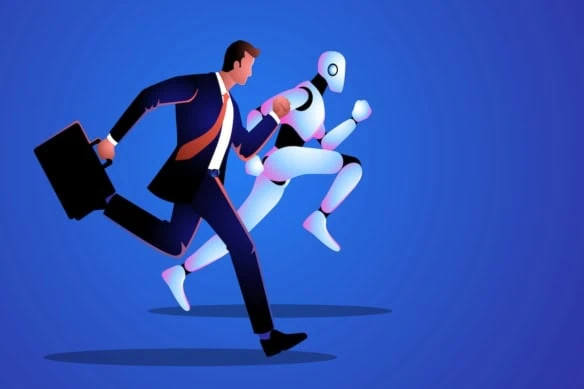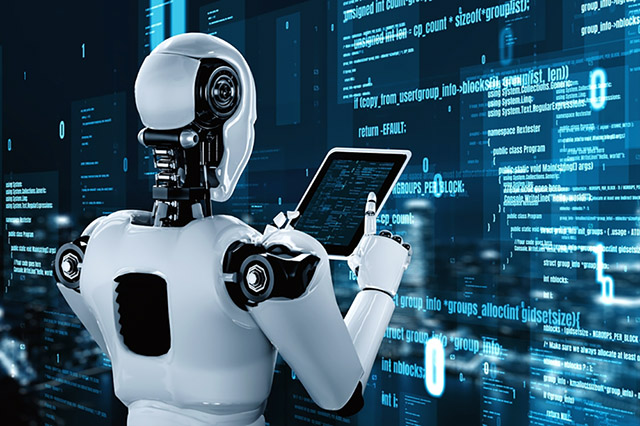Rapid advances in artificial intelligence (AI) technologies are prompting companies the world over to re-evaluate how they do business—and prompting an uncomfortable conversation about the future of work.
On the employer side, companies are scrambling to determine how they can implement AI in their businesses. For some, it’s an earnest attempt to improve the quality of their operations; for others it’s little more than a cost-cutting game; and for some, it’s a cynical attempt to generate positive publicity by linking their name to the hot buzzword du jour.
On the employee side, views of AI run the gamut. Some workers are embracing AI tools, seeing ways to make their work easier and more efficient. Others are rejecting it from a quality standpoint, pointing out its propensity for “hallucinating” (providing inaccurate information). And still others are just waiting for what they feel is inevitable—AI taking their jobs completely, leaving them without a job and forced to reskill mid-career just to survive.
While we have no idea what the future holds until it happens, a host of research suggests that certain occupations and industries will face more AI disruption than others. Some employees might feel little to no effect from artificial intelligence, others might need to shift into related but different roles as AI handles more tasks that humans do, and still others might find themselves completely on the outs.
Today, we’re going to look at several jobs that are most susceptible to AI advancements.
Table of Contents
General Trends Around AI Job Replacement
McKinsey Global Institute—the economic and business research arm of consulting firm McKinsey & Co.—laid out a host of employment data, analysis, and predictions in its July 2023 report, Generative AI and the future of work in America.
Among some of the broader takeaways as it pertains to AI:
— By 2030, tens of millions of Americans will face “occupational transitions,” where their jobs significantly transform or even disappear because of AI.
— Automation could replace human tasks that account for nearly 30% of the hours worked in the U.S. economy.
— The jobs most susceptible to AI are ones that involve repetitive tasks, such as data collection and elementary data processing.
— Lower-wage jobs are much more likely to suffer from automation than higher-wage jobs. Specifically, those earning less than $30,800 a year and those earning $30,800 to $38,200 per year “are up to 10 and 14 times more likely, respectively, to need to change occupations by the end of this decade than the highest earners.”
— Jobs in those two lowest wage quintiles are “disproportionately held” by women, people of color, and people with less education.
— The demand for basic cognitive and manual skills is likely to decline but not go away completely. Conversely, the labor market could have higher demand for social-emotional and digital skills.
Jobs That Could Be Disrupted by AI
Which roles specifically have a high chance of being replaced by AI (or otherwise automated)?
Today, we’re going to look through a handful of professions that McKinsey has singled out for its vulnerability to AI, and that Bureau of Labor Statistics (BLS) analysis also says is projected to decline over the next decade or so.
Just keep in mind that these are merely projections. In many cases, there have been wide gaps between the widely touted proclamations of what certain AI tools and programs can do and what they can actually do (and how well they can do it). It’s possible that some of these job losses will never come to be. Conversely, AI-related employment declines might be worse than expected. And artificial intelligence could easily impact many more job types not mentioned here.
In no particular order …
1. Clerks

McKinsey estimates that the demand for clerk positions could decline by 1.6 million jobs by 2030. It defines the role as “receptionists and information clerks, general office clerks, bookkeeping, accounting, and auditing clerks, and shipping, receiving, and inventory clerks.”
This broader concept is reflected in Bureau of Labor Statistics (BLS) data, which shows more than a dozen different clerk-related occupations that are expected to sustain declines in employment between 2022 and 2032.
Some of the worst projections? Financial clerks are expected to face a 14%-plus decline in jobs, file clerks and payroll and timekeeping clerk employment is projected to drop by 16%, and information clerk employment is estimated to wither by more than 18% by 2032.
All of these types of jobs involve some highly repetitive tasks that automated systems are expected to perform sufficiently.
Related: 10 Best Dividend Stocks to Buy [Steady Eddies]
2. Retail Sales Workers

Retail sales workers assist consumers in finding products inside of a physical store and process payments for anything they decide to buy. When applicable, they may answer questions about the products and explain any current promotions.
McKinsey estimates that 830,000 American retail salesperson jobs could disappear by 2030. The BLS also predicts an employment decline for these positions, but at an estimated 2.2% decrease, that would only amount to roughly 80,000 job losses by 2032—a much less pessimistic view for the profession.
I should point out that AI isn’t the only threat to retail sales jobs. Per the BLS: “The increase in online sales is expected to continue over the projections decade, limiting growth in the number of physical retail stores and reducing demand for retail sales workers.”
Related: 7 Best Wealth + Net Worth Tracker Apps [View All Your Assets]
3. Administrative Assistants

Administrative assistants handle a hodgepodge of tasks for offices, such as scheduling appointments, drafting correspondences, and creating spreadsheets or reports. Some of these tasks are the same as what clerks do. You can find administrative assistants across a wide variety of industries, but they are particularly popular within the education industry and hospitals.
McKinsey research estimates that administrative assistant positions might decrease by 710,000 by 2030. The BLS also expects a decline in administrative assistants across a half-dozen categories. But those in the legal sector are worst off, with the BLS projecting job losses of nearly 22% by 2032.
These positions include data collection and other repetitive tasks, and thus, they are prime candidates for automation. Also, declines for this kind of role would disproportionately impact women, who hold an outsized number of office support jobs.
Related: 12 Best Apps That Give You Money for Signing Up [Free Money]
4. Cashiers
Whether at a gas station, grocery store, or other retail location, you’ve likely had a cashier process your payment and offer you a receipt. The cashier may have also greeted you and engaged in polite conversation while scanning your items.
Sadly, McKinsey sees a lot of those smiling faces being forced to work elsewhere.
McKinsey estimates that cashiers could decline by roughly 630,000 jobs by 2030. The BLS sees a decline of roughly half that—348,100—by 2032, though that’s still a steep decline of more than 10%.
As previously mentioned, low-paying jobs that require little education tend to be at a higher risk for automation. Usually, cashier work has no formal education requirements.
However, maybe it won’t be so bad. The BLS mentions that “employment of cashiers is expected to decline because of advances in technology, such as the use of self-service checkout stands in retail stores and increasing online sales.” That said, there are signs that this tide is turning. A few prominent retailers, most notably Walmart and Dollar General, have been eliminating self-checkout in select stores in recent months, citing higher rates of theft and other issues with the technology.
Related: 20 Junk Fees We Hate Paying [And How to Avoid Them]
5. Production Workers

Production workers include people who either work at production or manufacturing facilities. These jobs often involve manual tasks along an assembly line, including assembling, packaging, and quality control, though sometimes they involve operating machinery.
Unfortunately, some of these blue-collar jobs are highly susceptible to automation and replacement by AI.
In manufacturing, McKinsey says “roughly 36% of working hours could be affected by automation.” The BLS also predicts a 9.3% decline in production worker employment between 2022 and 2023. But job displacement won’t be even across the board. For instance, while there is a high chance there will be fewer machine operators and assemblers, the industry will likely need more software developers and industrial engineers.
Some manufacturing jobs include highly repetitive tasks, which can often be automated. If workers want to switch to high-skilled roles, such as industrial engineers, they will need to learn new skills. If there’s any upside to this, those who do successfully transition should be rewarded with higher pay.
Related: 5 Best Fidelity Retirement Funds [Low-Cost + Long-Term]
6. Food Services

Broadly speaking, the food service industry includes any business that serves food to customers. While restaurants are probably first to mind, these roles also include jobs in catering, cafeterias, vending companies, and more.
Food services jobs have some of the highest technical automation potential, says McKinsey, The BLS predicts food preparation workers are likely to decline by around 4.8% by 2032.
One of the main reasons these jobs have such great potential for being automated is that they involve predictable, physical work. This isn’t true for every task, of course. Measuring ingredients is a predictable task that a machine can handle, sure … but determining whether a spice has lost its potency and more needs to be added is still a job more fitted for a human.
Hispanic and black workers make up a large portion of workers in this field, and thus are expected to be the most heavily affected by increased AI use.
Related: Stop Shrinkflation! 10 Products Affected + Tips to Save Money
Will Any Jobs Grow in the Age of AI?

Hopefully, this discussion about the jobs artificial intelligence can manage didn’t make you too fearful of a jobless future for humans.
Indeed, McKinsey anticipates several types of professions will grow in the coming years. The health care industry takes the lead—by 2030, the industry could need an additional 3.5 million jobs in roles such as health technician, health aid, and wellness worker, not to mention 2 million more health care professionals.
A few of the other professions McKinsey expects to increase are STEM (science, technology, engineering, and mathematicss) jobs, transportation, education and training, and construction.
Put simply: The rise of AI might result in fewer jobs for some industries, but not all.
Related: 6 Best Stock Recommendation Services [Stock Picking + Tips]

Stock recommendation services are popular shortcuts that help millions of investors make educated decisions without having to spend hours of time doing research. But just like, say, a driving shortcut, the quality of stock recommendations can vary widely—and who you’re willing to listen to largely boils down to track record and trust.
The natural question, then, is “Which services are worth a shot?” We explore some of the best (and best-known) stock recommendation services.
Related: 12 Best Long-Term Stocks to Buy and Hold Forever
As even novice investors probably know, funds—whether they’re mutual funds or exchange-traded funds (ETFs)—are the simplest and easiest ways to invest in the stock market. But the best long-term stocks also offer many investors a way to stay “invested” intellectually—by following companies they believe in. They also provide investors with the potential for outperformance.
So if your’e looking for a starting point for your own portfolio, look no further. Check out our list of the best long-term stocks for buy-and-hold investors.
Related: Best Target-Date Funds: Vanguard vs. Schwab vs. Fidelity

Looking to simplify your retirement investing? Target-date funds are a great way to pick one fund that aligns with when you plan to retire and then contribute to it for life. These are some of the best funds to own for retirement if you don’t want to make any investment decisions on a regular basis.
We provide an overview of how these funds work, who they’re best for, and then compare the offerings of three leading fund providers: Vanguard, Schwab, and Fidelity.
Related: 9 Best Monthly Dividend Stocks for Frequent, Regular Income

The vast majority of American dividend stocks pay regular, reliable payouts—and they do so at a more frequent clip (quarterly) than dividend stocks in most other countries (typically every six months or year).
Still, if you’ve ever thought to yourself, “it’d sure be nice to collect these dividends more often,” you don’t have to look far. While they’re not terribly common, American exchanges boast dozens of monthly dividend stocks.
Please Don’t Forget to Like, Follow and Comment

Did you find this article helpful? We’d love to hear your thoughts! Leave a comment with the box on the left-hand side of the screen and share your thoughts.
Also, do you want to stay up-to-date on our latest content?
1. Follow us by clicking the [+ Follow] button above,
2. Subscribe to The Weekend Tea, our weekly newsletter to read more about investing, spending, taxes, and more, and
3. Give the article a Thumbs Up on the top-left side of the screen.
4. And lastly, if you think this information would benefit your friends and family, don’t hesitate to share it with them!









